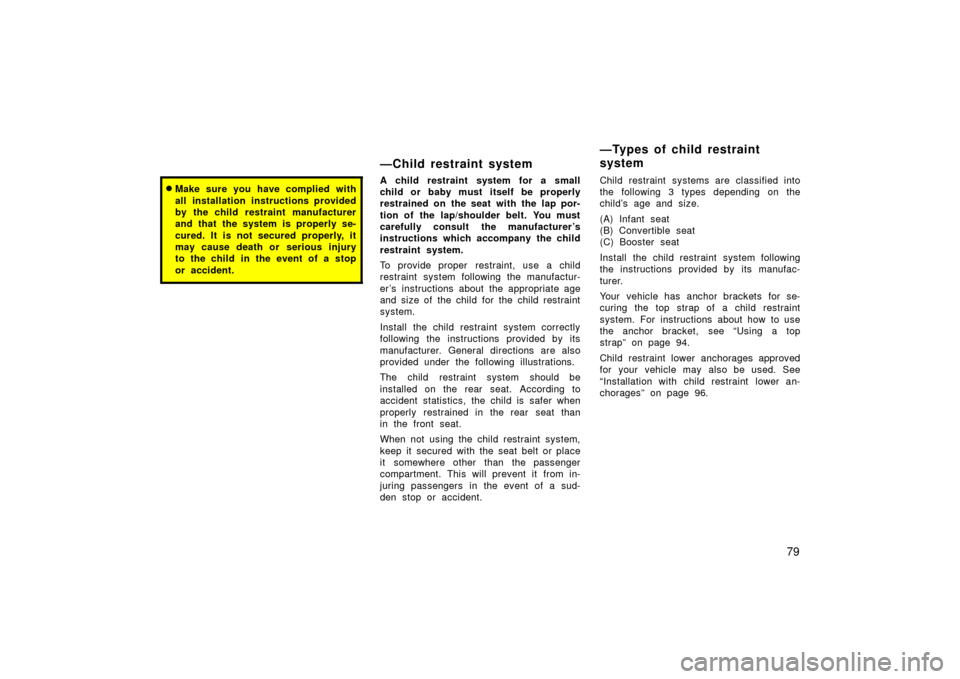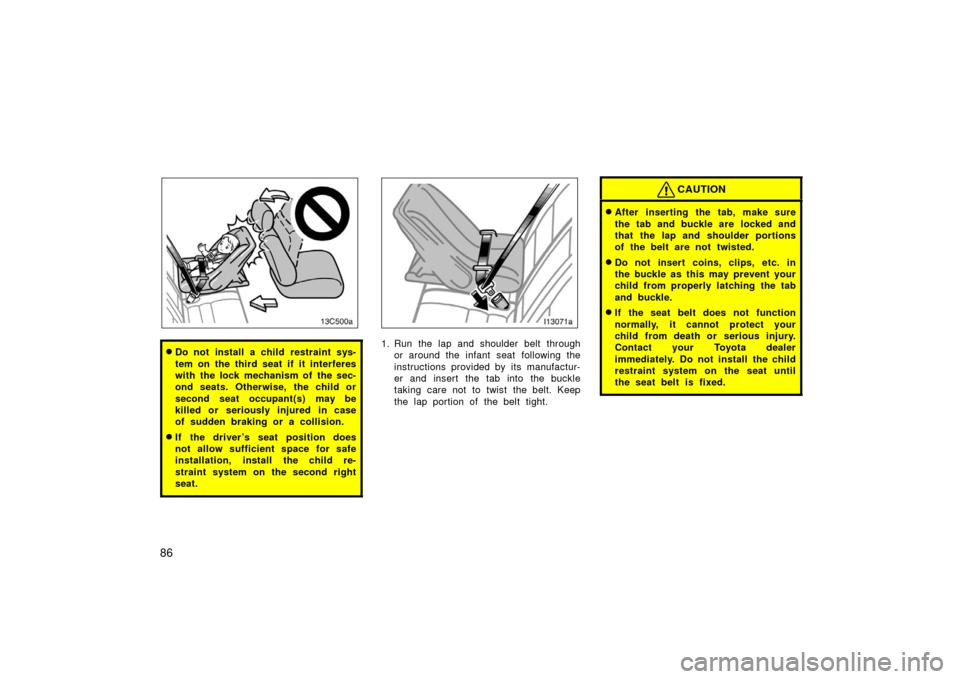Page 88 of 364

78
Toyota strongly urges the use of ap-
propriate child restraint systems for
children.
The laws of all 50 states in the U.S.A.
now require the use of a child restraint
system.
Your vehicle conforms to SAEJ1819.
If a child is too large for a child restraint
system, the child should sit in the rear
seat and must be restrained using the
vehicle’s seat belt. See “Seat belts” on
page 50 for details.
CAUTION
�For effective protection in automo-
bile accidents and sudden stops, a
child must be properly restrained,
using a seat belt or child restraint
system depending on the age and
size of the child. Holding a child in
your arms is not a substitute for a
child restraint system. In an acci-
dent, the child can be crushed
against the windshield, or between
you and the vehicle’s interior.
�Toyota strongly urges use of a
proper child restraint system which
conforms to the size of the child,
installed on the rear seat. Accord-
ing to accident statistics, the child
is safer when properly restrained in
the rear seat than in the front seat.
�Never install a rear�facing child re-
straint system on the front passen-
ger seat. In the event of an acci-
dent, the force of the rapid inflation
of the front passenger airbag can
cause death or serious injury to the
child if the rear�facing child re-
straint system is installed on the
front passenger seat.
�A forward�facing child restraint sys-
tem should be allowed to be
installed on the front passenger
seat only when it is unavoidable.
Always move the seat as far back
as possible, because the front pas-
senger airbag could inflate with
considerable speed and force.
Otherwise, the child may be killed
or seriously injured.
�On vehicle with side airbags and
curtain shield airbags, do not allow
the child to lean his/her head or
any part of his/her body against the
door or the area of the seat, front
or rear pillar, front, center or rear
garnish or roof interior from which
the side airbags or curtain shield
airbags deploy even if the child is
seated in the child restraint system.
It is dangerous if the side airbag
and curtain shield airbag inflate,
and the impact could cause death
or serious injury to the child.
�Do not use the seat belt extender
when installing a child restraint
system on the front or rear passen-
ger seat. If installing a child re-
straint system with the seat belt
extender connected to the seat belt,
the seat belt will not securely hold
the child restraint system, which
could cause death or serious injury
to the child or other passengers in
the event of collision.
Child restraint—
—Child restraint precautions
Page 89 of 364

79
�Make sure you have complied with
all installation instructions provided
by the child restraint manufacturer
and that the system is properly se-
cured. It is not secured properly, it
may cause death or serious injury
to the child in the event of a stop
or accident.
—Child restraint system
A child restraint system for a small
child or baby must itself be properly
restrained on the seat with the lap por-
tion of the lap/shoulder belt. You must
carefully consult the manufacturer ’s
instructions which accompany the child
restraint system.
To provide proper restraint, use a child
restraint system following the manufactur-
er ’s instructions about the appropriate age
and size of the child for the child restraint
system.
Install the child restraint system correctly
following the instructions provided by its
manufacturer. General directions are also
provided under the following illustrations.
The child restraint system should be
installed on the rear seat. According to
accident statistics, the child is safer when
properly restrained in the rear seat than
in the front seat.
When not using the child restraint system,
keep it secured with the seat belt or place
it somewhere other than the passenger
compartment. This will prevent it from in-
juring passengers in the event of a sud-
den stop or accident.Child restraint systems are classified into
the following 3 types depending on the
child’s age and size.
(A) Infant seat
(B) Convertible seat
(C) Booster seat
Install the child restraint system following
the instructions provided by its manufac-
turer.
Your vehicle has anchor brackets for se-
curing the top strap of a child restraint
system. For instructions a
bout how to use
the anchor bracket, see “Using a top
strap” on page 94.
Child restraint lower anchorages approved
for your vehicle may also be used. See
“Installation with child restraint lower an-
chorages” on page 96.
—Types of child restraint
system
Page 91 of 364
81
CAUTION
Do not install a child restraint system
on the third seat if it interferes with
the lock mechanism of the second
seats. Otherwise, the child or second
seat occupant(s) may be killed or se-
riously injured in case of sudden
braking or a collision.
1. Run the center lap belt through or around the infant seat following the
instructions provided by its manufactur-
er and insert the tab into the buckle
taking care not to twist the lap belt.
CAUTION
�After inserting the tab, make sure
the tab and buckle are locked and
that the lap portion of the belt is
not twisted.
�Do not insert coins, clips, etc. in
the buckle as this may prevent you
from properly latching the tab and
buckle.
�If the seat belt does not function
normally, it cannot protect your
child from death or serious injury.
Contact your Toyota dealer
immediately. Do not install the child
restraint system on the seat until
the seat belt is fixed.
Page 92 of 364
82
2. While pressing the infant seat firmlyagainst the seat cushion and seatback,
tighten the lap belt by pulling its free
end to hold the infant seat securely.CAUTION
Push and pull the child restraint sys-
tem in different directions to be sure
it is secure. Follow all the installation
instruction provided by its manufac-
turer.
3. To remove the infant seat, press thebuckle release button.
Page 93 of 364
83
(B) CONVERTIBLE SEAT INSTALLATION
A convertible seat must be used in for-
ward�facing or rear�facing position de-
pending on the age and size of the
child. When installing, follow the
manufacturer ’s instruction about the ap-
plicable age and size of the child as
well as directions for installing the
child restraint system.CAUTION
Do not install a child restraint system
on the third seat if it interferes with
the lock mechanism of the second
seats. Otherwise, the child or second
seat occupant(s) may be killed or se-
riously injured in case of sudden
braking or a collision.
1. Run the center lap belt through or around the convertible seat following
the instructions provided by its
manufacturer and insert the tab into
the buckle taking care not to twist the
lap belt.
Page 94 of 364
84
CAUTION
�After inserting the tab, make sure
the tab and buckle are locked and
that the lap portion of the belt is
not twisted.
�Do not insert coins, clips, etc. in
the buckle as this may prevent you
from properly latching the tab and
buckle.
�If the seat belt does not function
normally, it cannot protect your
child from death or serious injury.
Contact your Toyota dealer
immediately. Do not install the child
restraint system on the seat until
the seat belt is fixed.
2. While pressing the convertible seatfirmly against the seat cushion and
seatback, tighten the lap belt by pulling
its free end to hold the convertible seat
securely.CAUTION
Push and pull the child restraint sys-
tem in different directions to be sure
it is secure. Follow all the installation
instructions provided by its manufac-
turer.
Page 95 of 364
85
3. To remove the convertible seat, pressthe buckle release button. 13c564(A) INFANT SEAT INSTALLATION
An infant seat must be used in rear�
facing position only.
13c565
CAUTION
�Never install a rear�facing child re-
straint system on the front passen-
ger seat. In the event of an acci-
dents, the force of the rapid infla-
tion of the front passenger airbag
can cause death or serious injury
to the child if the rear�facing child
restraint system is installed on the
front passenger seat.
—Installation with 3�point
type seat belt
Page 96 of 364

86
�Do not install a child restraint sys-
tem on the third seat if it interferes
with the lock mechanism of the sec-
ond seats. Otherwise, the child or
second seat occupant(s) may be
killed or seriously injured in case
of sudden braking or a collision.
�If the driver ’s seat position does
not allow sufficient space for safe
installation, install the child re-
straint system on the second right
seat.
1. Run the lap and shoulder belt throughor around the infant seat following the
instructions provided by its manufactur-
er and insert the tab into the buckle
taking care not to twist the belt. Keep
the lap portion of the belt tight.
CAUTION
�After inserting the tab, make sure
the tab and buckle are locked and
that the lap and shoulder portions
of the belt are not twisted.
�Do not insert coins, clips, etc. in
the buckle as this may prevent your
child from properly latching the tab
and buckle.
�If the seat belt does not function
normally, it cannot protect your
child from death or serious injury.
Contact your Toyota dealer
immediately. Do not install the child
restraint system on the seat until
the seat belt is fixed.